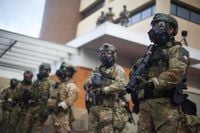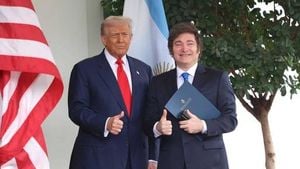Federal immigration enforcement actions in American cities have ignited a new wave of controversy, legal battles, and public outrage, as recent events in Chicago and Portland lay bare the escalating tensions between local communities, law enforcement, and the Trump administration’s approach to border security. In the past month, a series of confrontations and court cases have unfolded, revealing a complex landscape of clashing priorities, alleged civil rights violations, and fierce debates over the limits of federal power.
In Chicago’s Little Village neighborhood, a federal immigration raid on October 23, 2025, became the flashpoint for a dramatic and disturbing incident. According to court filings reported by Block Club Chicago, a combat veteran alleged that a masked federal agent pointed a handgun at his face from inside a car, uttering the chilling words, “bang, bang,” followed by, “you’re dead, liberal.” The veteran, whose name was withheld for safety, described the encounter as deeply traumatizing. “I want to stand up for my community members and to criticize abuse of government power, but after experiencing a gun pointed at my face by a government official, I fear for my safety if I continue to outwardly express my support by my presence and my words for my community and the ideals I expect my government to uphold,” he stated in court documents.
This incident was just one in a string of aggressive enforcement actions that have swept through Chicago in recent weeks. Federal agents, including Border Patrol chief Greg Bovino, used tear gas and pepper spray on protesters gathered near the Discount Mall on West 26th Street. Despite a temporary restraining order issued by U.S. District Judge Sara Ellis on October 9, which barred federal agents from deploying riot control weapons against journalists and peaceful protesters, reports indicate that agents have used tear gas at least five times since the order—in Albany Park, East Side, Little Village, Old Irving Park, and Avondale.
Court documents detail multiple violations of the restraining order during the Little Village raid. Agents allegedly fired pepper balls at close range, used tear gas and pepper spray on non-threatening protesters, launched gas canisters and compressed air munitions at sensitive body areas, and physically assaulted individuals who posed no immediate threat. The agents also reportedly failed to provide the required audible warnings before deploying riot control weapons. Judge Ellis, upon hearing these accounts, admonished Bovino, ordering him to provide daily reports on federal agent activity and supply body-camera footage and use-of-force reports dating back to early September.
Chicago’s mayor, Brandon Johnson, did not mince words at a press conference, lambasting the federal operations and singling out Bovino as a “barbaric individual.” Johnson voiced skepticism about whether the court’s accountability measures would truly rein in what he characterized as unchecked federal aggression. “The Trump administration has a strong proclivity to lie,” Johnson asserted. “The Trump administration said they were going to go after the ‘worst of the worst.’ Criminals, individuals who have caused harm. And that’s not what’s happening. So what is happening is, Bovino is a barbaric individual. And I just hope that this judge provides some level of accountability.”
The impact of these raids has rippled through Chicago’s neighborhoods. On October 24, a man was detained by immigration officials near Paulina and Superior streets in West Town while waiting for a family member outside the Erie Neighborhood House, a social service agency serving Latino clients. According to Erie’s executive director, Cristina De La Rosa, the man was legally in the United States on a work permit and had a pending immigration court date. “They ended up breaking his window to open the door and dragged him out. And then detained him in one of their vehicles and they drove off,” De La Rosa recounted. The arrest rattled the organization’s clients and led to the cancellation of community events, though Erie Neighborhood House remained open to provide crucial services.
Federal enforcement actions have not been limited to Chicago. In Portland, Oregon, a parallel drama has unfolded, with local and state officials locked in a high-stakes legal battle against the Trump administration’s deployment of federal officers and the attempted mobilization of National Guard troops. According to The Oregonian, in the month leading up to October 29, federal officers fired tear gas and pepper balls at Portland police officers outside the U.S. Immigration and Customs Enforcement (ICE) building. When Portland police confronted federal agents about striking one of their officers, the federal response was blunt: “help or get out of the way.”
This confrontation is now at the heart of a trial that began on October 29, with Oregon, the city of Portland, and California challenging President Trump’s September 27 order to deploy National Guard troops to Portland. Lawyers for the states and city argue that the increased federal presence since late September has only worsened the situation, with federal officers arbitrarily firing tear gas, pepper balls, and smoke canisters at protesters and bystanders. They are seeking a permanent injunction to bar the deployment of National Guard members to Portland’s ICE facility.
Federal officials, however, contend that local police have been “unhelpful” and “hostile,” failing to assist in protecting federal property or officers during ongoing protests that have persisted since June. The U.S. Department of Justice argues that the Portland Police Bureau’s policy against assisting with immigration enforcement goes beyond ordinary law enforcement and has left federal officers exposed to danger. They cite damage to the ICE building, blockades, and threats against officers as justification for their actions and for the president’s authority to federalize the National Guard under Title 10, Section 12406 of the federal code.
The legal battle has become a showcase for the broader struggle over American federalism and the limits of presidential power. More than 1,200 exhibits, including social media posts, protest videos, and incident reports, have been submitted as evidence. The 9th U.S. Circuit Court of Appeals is currently reviewing the legality of a temporary order that bars federal control of Oregon National Guard members, with both sides preparing for a drawn-out appeals process regardless of the trial’s outcome.
Back in Chicago, the federal enforcement campaign has continued unabated. On October 28, multiple sightings and arrests involving federal immigration agents were reported across the city and suburbs—from the Southwest Side to Burnham—further stoking anxiety among immigrant communities and local activists. Meanwhile, local organizations and rapid response teams have mobilized to monitor ICE activity, provide legal assistance, and educate residents about their rights.
As the legal and political battles rage on, these recent events in Chicago and Portland underscore the profound and often painful consequences of the nation’s fractured approach to immigration enforcement. The coming weeks promise further court rulings, community mobilizations, and, inevitably, more stories from those caught in the crossfire of this contentious debate.




